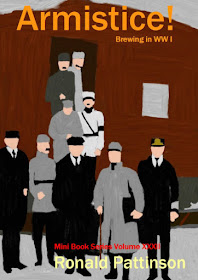The supply of raw materials was getting so tight that, in early 1942, the weaker sort of beer was allowed to be 80% malt and 20% sugar. Gravities were also cut again. Even the stronger category was down to just 3% ABV.
To put this into context, UK average OG in 1942 was 1035.53. Which would have left average ABV around 3.5%. But, most importantly, it would remain at that level until 1946. While in Germany gravities would continue to fall until they reached ridiculously low levels.
"The breweries are then taken care of until 1945 without carryover and will then only have the regular beer stock. The German side was informed that decisions have now been made in Germany about the beer gravity and the beer production in 1942. Production will be reduced by 1/4 part from 1941, while 55,000,000 tons of barley will be made available. As of February 1, 1942, the beer sold will have a lower gravity, namely:
a. 25% of the production (14,000,000 hl.) 7.7%
b. 75% of the production (30,000,000 hl.) +-4.0%.
This second type of beer will be produced from malt, insofar as a content of 3.3 to 3.5% can be obtained therefrom, while sugar can be used in the manufacture of this beer in a ratio of 20 kg. sugar at 80 kg. malt to increase the gravity. According to the German side, the average gravity would be 5 to 5.1%. According to calculations by the C.B.K. however, this comes to 5.3 to 5.5%. The German authorities considered that, in view of the measures taken in Germany, an average level of 6.5% in the Netherlands would probably be unsustainable. It was pointed out from the Dutch official side that the raw material supply of the Dutch breweries in relation to the German tonnage amounts to a lower calorific value in beer per Dutch person. On this occasion the Speaker warned of the dangers to the company associated with such a sharp reduction in the gravity, as has been shown in Belgium, for example. Moreover, if one were to get a situation like that in Belgium in the Netherlands, this would have social consequences.
Finally, it was agreed to wait for the experience to be gained in Germany with the gravity reduction and to end this subject. March to be discussed again, so that any preparation can start on April 1 and a change can take effect on May 1."
Minutes of the management of the CBK on 22nd December 1941, held at the Amsterdam City Archives, document number 31121-1, page 70.
Note that only 25% of a brewer's output could be in the stronger category. Even with the addition of sugar, the weaker category was only a little over 2% ABV. So a bit of a waste of ti,e. Though I should point out that there were many very low ABV German top-fermenting beers. Things even weaker than Berliner Weisse. Some German drinkers were already accustomed to piss-weak beer.















